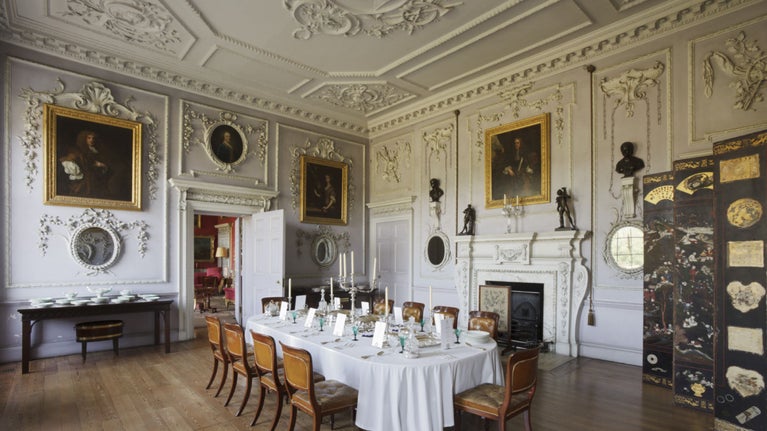
Discover more at Felbrigg
Find out when Felbrigg Hall, Gardens and Estate is open, how to get here, things to see and do and more.

One of the most elegant country houses in East Anglia. Discover a place of surprises and delights, a mixture of opulence and homeliness where each room stirs the imagination
Felbrigg Hall will partially reopen at weekends only from February and will fully reopen during the half term school holiday.
Several of the stained-glass windows in the Great Hall date from the 15th century, some reinstalled from St Peter Mancroft Church in Norwich. The Yorkist lion and fetterlock badge can be seen throughout the house and on the estate.
The dining room was created by William Windham II between 1752 and 1755, where the original 1680s staircase stood. Currently the table takes you through 400 years of dining, including the do’s and the don’ts of table etiquette.
Known originally as the Great Parlour, this was the main reception and dining room throughout the late 17th century, panelled in oak and hung with pictures.
Remodelled in 1751 by James Paine, the original ceiling dating back to 1687 was kept along with its intricate plasterwork, showing game birds, fruit and flowers to reflect the room's original function.

Originally the 17th century drawing room was square and panelled, until the bay window was added in 1751. William Windham II transformed this space into a Cabinet to display the pictures and objects he had collected on a European Grand Tour.
The most complete surviving Grand Tour Cabinet in England, this room also houses luxury furniture traded by the East India Company.
This atmospheric Gothic room was probably the Great Chamber of the Jacobean house and was made into a library by William Windham II between 1752 and 1755. The collection contains approximately 5,000 books, including a copy of Dr Johnson's famous dictionary. The oldest book dates from 1509.
Originally two rooms, these were united in 1751 when the bay window was built. The wallpaper was imported by the East India Company and block-printed and hand-painted in China. A specialist had to be engaged to hang the paper at a cost of 3s 6d (about £20 today) per day and 6d per travelling mile. William Windham II thought this was 'a cursed deal'.

- Brinsley Ford, art historian, scholar and collector, on Felbrigg in the 1950s
In Victorian times, a house like Felbrigg had to be self-sufficient in many ways. A separate room was provided for every domestic task: Game Larder, Bake House, Pump House, Brew House, Larder, Scullery – and that’s just the rooms that aren’t usually on show.
The kitchen you see today has been in the same spot since the early 18th century. There are two long oak tables, one is 18th century, the other Victorian. The last squire of installed an Aga. The pewter and highly polished copper batterie de cuisine is typical of historic country house kitchens and original to Felbrigg.
Fire is an ever-present danger in the country house, especially in its kitchens. One rudimentary precaution at Felbrigg was a set of leather and metal fire buckets, which bear Rachel Anne Ketton's initials.
William Windham II enjoyed working with his hands and used this room for the popular 18th-century pastime of wood and ivory turning. He also stored an arsenal of sporting weapons here, with 42 guns in the upper shop alone. The room above contained his book-binding and gilding tools.

Find out when Felbrigg Hall, Gardens and Estate is open, how to get here, things to see and do and more.

Discover more about the history of Felbrigg Hall in Norfolk, its past owners and how it came to be in the care of the National Trust.

In 1969, R.W. Ketton-Cremer, gave Felbrigg to the National Trust. Today, Felbrigg Hall is home to one of the Trust’s largest collections. Here are some of the highlights.

Discover the gardens at Felbrigg, including the widely renowned Walled Garden, bursting at the seams with heady colour, fragrance and textures.

Discover the important conservation work that takes place daily within the hall at Felbrigg, and look back at some of the important projects that have taken place in recent years.

Discover volunteering opportunities at Felbrigg Hall. From supporting the garden team to helping out with events, there is something for everyone to get involved with.

Historic buildings are a treasure trove of stories, art and collections. Learn more about their past and plan your next visit.

From a recently restored 500-year-old moated manor house to the largest windpump in the Norfolk Broads, Norfolk is home to several must-see houses and buildings.